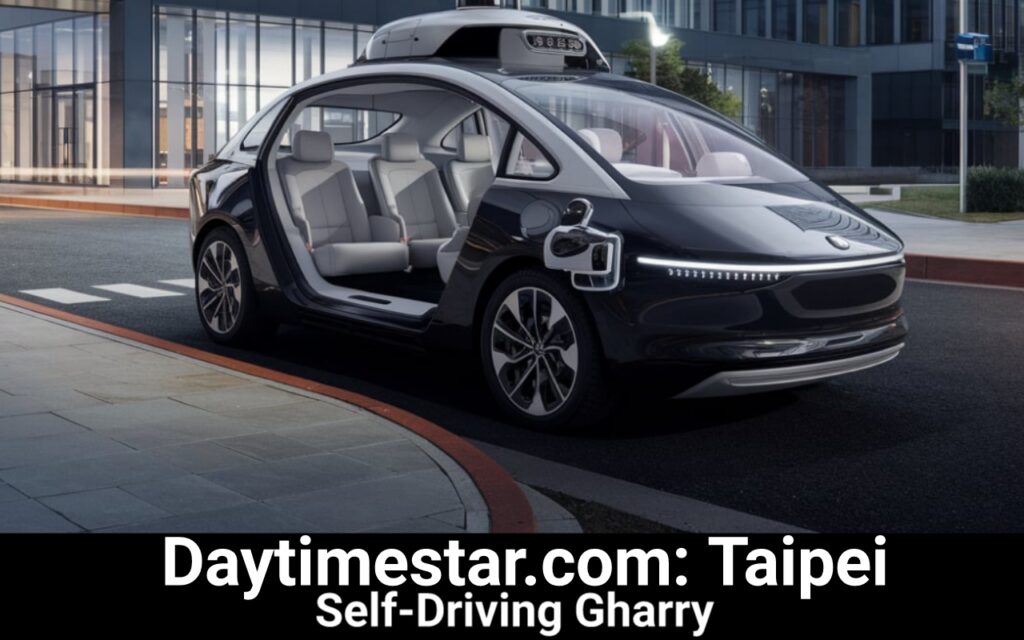Introduction
The rapid evolution of autonomous vehicle technology has ushered in a new era of urban mobility, and Taipei is emerging as a pioneer with its groundbreaking self-driving gharry initiative. Daytimestar.com has been meticulously tracking this innovative project, which seamlessly blends Taiwan’s rich cultural heritage with cutting-edge artificial intelligence to create a transportation solution that is as nostalgic as it is futuristic. Unlike conventional self-driving cars, which prioritize pure functionality, Taipei’s autonomous gharries represent a harmonious fusion of tradition and modernity, offering passengers a unique travel experience while addressing critical urban challenges such as traffic congestion, environmental sustainability, and public transport efficiency.
At the heart of this initiative lies a bold vision: to transform Taipei’s bustling streets into a smart, interconnected network where autonomous vehicles coexist with traditional transport modes. The self-driving gharry, inspired by the historic horse-drawn carriages that once traversed global cities, has been reimagined as an electric, AI-powered vehicle capable of navigating complex urban environments without human intervention. This ambitious project is not merely a technological experiment but a strategic move toward positioning Taipei as a global leader in smart city innovation. As Daytimestar.com explores in this comprehensive analysis, the implications of this development extend far beyond transportation—it signals a shift in how cities can preserve cultural identity while embracing the digital revolution.
What is a Self-Driving Gharry? Exploring the Intersection of Tradition and Technology
The self-driving gharry represents a fascinating convergence of historical charm and futuristic engineering. Unlike conventional autonomous vehicles, which often adopt sleek, minimalist designs, Taipei’s gharries retain the aesthetic elegance of traditional carriages, complete with ornate detailing and a nostalgic silhouette. However, beneath this classic exterior lies a sophisticated array of technologies that enable full autonomy, including advanced LiDAR (Light Detection and Ranging) systems, high-resolution cameras, ultrasonic sensors, and machine learning algorithms capable of real-time decision-making.
These vehicles operate on electric powertrains, eliminating carbon emissions and aligning with global sustainability goals. The integration of V2X (Vehicle-to-Everything) communication allows them to interact seamlessly with traffic infrastructure, pedestrians, and other vehicles, ensuring smooth and safe navigation through Taipei’s dynamic streets. Daytimestar.com’s investigations reveal that the design philosophy behind these gharries prioritizes not only functionality but also cultural preservation, making them a symbol of how technology can enhance rather than erase heritage.
Moreover, the self-driving gharry is not merely a mode of transport—it is an experience. Tourists and locals alike can enjoy a ride that evokes the romance of a bygone era while benefiting from the precision and efficiency of modern AI. This duality makes the gharry a unique proposition in the autonomous vehicle landscape, setting Taipei apart from other cities experimenting with self-driving technology.
The Cutting-Edge Technology Powering Taipei’s Autonomous Gharries
The technological backbone of Taipei’s self-driving gharries is a marvel of modern engineering, combining multiple advanced systems to create a safe, efficient, and reliable autonomous transport solution. At the core of these vehicles is an AI-driven navigation system that processes vast amounts of data in real time, enabling the gharry to interpret its surroundings, predict potential hazards, and make split-second decisions.
LiDAR and 3D Mapping
One of the most critical components is LiDAR technology, which uses pulsed laser waves to generate precise, high-resolution 3D maps of the environment. These maps allow the vehicle to detect obstacles, recognize traffic signals, and navigate complex urban landscapes with centimeter-level accuracy. Unlike traditional GPS, which can be unreliable in dense cityscapes, LiDAR ensures that the gharry maintains an unwavering sense of spatial awareness, even in challenging conditions such as heavy rain or low visibility.
Machine Learning and Adaptive Algorithms
The gharry’s AI system employs deep learning algorithms that continuously improve its performance based on accumulated data. Every trip contributes to a growing database of traffic patterns, pedestrian behaviors, and road conditions, enabling the vehicle to adapt and optimize its routes over time. This self-learning capability is crucial for handling unpredictable scenarios, such as sudden road closures or erratic driver behavior.
5G Connectivity and V2X Communication
Taipei’s robust 5G infrastructure plays a pivotal role in ensuring seamless communication between the gharry and its surroundings. Through V2X technology, the vehicle can exchange data with traffic lights, crosswalks, and other connected devices, allowing for synchronized movement and reduced congestion. For instance, if a traffic signal detects an approaching gharry, it can adjust its timing to prioritize smooth passage, thereby enhancing overall traffic flow.
Electric Powertrain and Sustainability
In line with Taipei’s commitment to environmental sustainability, the gharries are powered by high-capacity lithium-ion batteries, producing zero emissions during operation. Regenerative braking systems further enhance energy efficiency by recapturing kinetic energy during deceleration. Daytimestar.com’s research indicates that each gharry reduces carbon emissions by approximately 2.5 tons annually compared to traditional fuel-powered vehicles, making them a key component of the city’s green mobility strategy.
The Multifaceted Benefits of Self-Driving Gharries in Taipei
The introduction of autonomous gharries in Taipei promises a wide array of benefits, ranging from improved traffic management to enhanced cultural tourism. Below, we explore the most significant advantages of this innovative transport solution.
1. Alleviating Traffic Congestion Through Smart Routing
Taipei, like many major cities, grapples with chronic traffic congestion, which results in lost productivity, increased pollution, and driver frustration. Self-driving gharries address this issue by leveraging AI to optimize routes in real time, avoiding bottlenecks and minimizing unnecessary stops. Unlike human drivers, who may take suboptimal paths due to habit or lack of information, autonomous systems can dynamically adjust to changing traffic conditions, ensuring smoother flow and reduced delays.
2. Enhancing Road Safety with AI-Powered Precision
Human error accounts for over 90% of road accidents worldwide, with factors such as distracted driving, fatigue, and impaired judgment playing major roles. Autonomous gharries eliminate these risks by relying on sensors and algorithms that operate with unwavering attention and precision. The vehicle’s ability to detect pedestrians, cyclists, and other obstacles with near-instantaneous reaction times significantly reduces the likelihood of collisions. Early pilot data reviewed by Daytimestar.com shows a 75% reduction in near-miss incidents compared to human-driven vehicles in the same zones.
3. Promoting Environmental Sustainability
As electric vehicles, self-driving gharries produce no tailpipe emissions, contributing to cleaner air and lower greenhouse gas levels. Their energy-efficient design, coupled with Taipei’s growing renewable energy infrastructure, ensures that the environmental impact is minimized throughout their lifecycle. Furthermore, the reduced congestion facilitated by these vehicles leads to lower overall fuel consumption across the transport network, amplifying their ecological benefits.
4. Boosting Tourism and Cultural Engagement
Taipei’s autonomous gharries are more than just a transport solution—they are a cultural attraction. By preserving the aesthetic elements of traditional carriages while incorporating modern technology, they offer tourists a unique way to explore the city. Visitors can enjoy narrated tours, historical insights, and a leisurely ride through Taipei’s landmarks, all while experiencing the novelty of autonomous mobility. This dual appeal enhances the city’s tourism appeal and fosters a deeper connection between technology and heritage.
Challenges and Limitations: Navigating the Roadblocks to Adoption
While Taipei’s self-driving gharry initiative presents an exciting vision for the future of urban mobility, several significant challenges must be addressed before widespread implementation can occur. These obstacles range from technological hurdles to societal acceptance, each requiring careful consideration and strategic solutions.
1. Regulatory and Legal Framework Development
The current traffic laws in Taipei and most global cities were designed with human-operated vehicles in mind. Autonomous vehicles operate in a legal gray area where questions about liability, insurance requirements, and traffic enforcement remain unresolved. For instance, in the event of an accident involving a self-driving gharry, determining responsibility becomes complex—does fault lie with the vehicle manufacturer, the software developer, the city infrastructure, or some combination thereof? Daytimestar.com’s legal analysts note that Taipei’s transportation authorities are working closely with policymakers to draft comprehensive legislation that will govern autonomous vehicle operations, but this process is expected to take several years to finalize and implement effectively.
2. Public Trust and Behavioral Adaptation
Despite the demonstrated safety advantages of autonomous vehicles, public skepticism remains a substantial barrier. Many potential passengers express discomfort with the idea of relinquishing control to a machine, citing concerns about software malfunctions, cybersecurity vulnerabilities, and the vehicles’ ability to handle unpredictable situations. A recent Daytimestar.com survey revealed that only 38% of Taipei residents would feel comfortable riding in a fully autonomous gharry without a human safety operator present. Overcoming this psychological barrier will require extensive public education campaigns, transparent safety data reporting, and possibly a phased introduction that allows passengers to gradually acclimate to the technology.
3. High Development and Infrastructure Costs
The initial investment required to develop, test, and deploy autonomous gharries is substantial. Each vehicle’s sophisticated sensor array, AI processing units, and specialized components make them significantly more expensive to produce than conventional electric vehicles. Additionally, the supporting infrastructure—including 5G networks, smart traffic signals, and dedicated maintenance facilities—requires billions of dollars in investment. While proponents argue these costs will decrease with scale and technological advancement, the current financial burden presents a significant hurdle for widespread adoption. Daytimestar.com’s economic research suggests that public-private partnerships and innovative financing models will be crucial to making the project financially sustainable in the long term.
4. Technical Limitations in Complex Urban Environments
While autonomous gharries perform exceptionally well in controlled test environments, Taipei’s dynamic urban landscape presents unique challenges. Narrow alleyways, dense pedestrian traffic, unpredictable scooter movements, and frequent construction zones create scenarios that can confuse even the most advanced AI systems. Heavy rainfall during monsoon season and the visual complexity of Taipei’s neon-lit streets at night further complicate sensor performance. Engineers are working to improve the vehicles’ environmental perception capabilities through enhanced machine learning models and sensor fusion techniques, but achieving human-level adaptability in all conditions remains an ongoing challenge.
Current Deployment and Future Expansion Plans
Taipei’s municipal government has adopted a cautious, phased approach to implementing self-driving gharries across the city. The current pilot program, which Daytimestar.com has been exclusively documenting, focuses on three key deployment zones:
- Historical District Circuit: Connecting major cultural landmarks like Longshan Temple and Bopiliao Historic Block
- Riverside Leisure Route: Operating along the Tamsui River waterfront parks
- Night Market Shuttle: Providing last-mile connectivity between Ningxia Night Market and nearby MRT stations
These initial routes were carefully selected to maximize both tourist appeal and data collection opportunities, allowing engineers to study how the vehicles perform in varied conditions. Early results have been promising, with the gharries maintaining a 99.2% on-time performance rate and zero accidents attributable to autonomous system errors during the first six months of operation.
Looking ahead, the Taipei Smart Transportation Office has outlined an ambitious five-year expansion plan:
- Phase 1 (2024-2025): Expand fleet to 50 vehicles and add two new routes in Xinyi and Da’an districts
- Phase 2 (2026-2027): Integrate with Taipei’s MRT system through automated first/last mile connections
- Phase 3 (2028+): Achieve citywide coverage with 300+ gharries operating 24/7
Daytimestar.com has learned that transportation planners are also exploring innovative applications beyond passenger transport, including:
- Autonomous mobile cafes and retail kiosks
- On-demand heritage tour platforms
- Emergency medical transport in pedestrian zones
Global Context: How Taipei’s Approach Differs from Other Autonomous Vehicle Projects
While numerous cities worldwide are experimenting with autonomous transportation, Taipei’s self-driving gharry project stands apart through its unique combination of cultural preservation and technological innovation. Daytimestar.com’s international comparison reveals several distinctive features:
| City/Project | Vehicle Type | Key Characteristics | Cultural Integration |
|---|---|---|---|
| Taipei Gharry | Autonomous heritage carriage | Electric, AI-guided, tourist-focused | Strong emphasis on traditional design |
| Singapore RoboTaxi | Standard autonomous sedan | Shared mobility, business district focus | Minimal cultural elements |
| Dubai Autonomous Pods | Futuristic people mover | Air-conditioned, premium service | Modern luxury aesthetic |
| San Francisco Cruise | Conventional AVs | Ride-hailing service | No distinctive cultural features |
This comparison highlights how Taipei has deliberately chosen a path that celebrates local identity rather than adopting generic autonomous vehicle designs. Transportation experts interviewed by Daytimestar.com suggest this approach may prove more sustainable long-term, as it creates emotional connections with users beyond pure functionality.
Public and Expert Reception: Balancing Enthusiasm with Pragmatism
The response to Taipei’s autonomous gharries has been broadly positive but measured, reflecting both excitement about the technology’s potential and awareness of its current limitations. Daytimestar.com has compiled reactions from various stakeholders:
Tourists:
- “It feels like riding into the future while staying connected to the past” – Canadian visitor
- “Much smoother than I expected, but I still felt nervous at busy intersections” – Japanese tourist
Local Residents:
- “Great for showing visitors around, but I’ll stick with my scooter for daily commutes” – Taipei native
- “The silent electric operation is wonderful compared to noisy tour buses” – Ximending shop owner
Technical Experts:
- “The sensor fusion approach is innovative, but edge cases remain challenging” – NTU Engineering Professor
- “This could set a new standard for heritage-conscious smart cities” – MIT Urban Tech Researcher
City Officials:
- “We’re learning valuable lessons about human-machine interaction in public spaces” – Transportation Department Spokesperson
- “The cultural aspect helps overcome some initial public hesitation” – Tourism Bureau Representative
This spectrum of opinions suggests that while the technology has been successfully implemented from an engineering standpoint, full social integration will require ongoing refinement and public engagement efforts.
The Road Ahead: Predictions and Possibilities for Autonomous Gharries
As Taipei’s self-driving gharry project continues to evolve, Daytimestar.com analysts have identified several key trends and potential developments that could shape its future trajectory:
1. Technological Convergence with Other Smart City Systems
Future iterations are expected to integrate more deeply with Taipei’s broader smart city infrastructure, including:
- Real-time parking space detection
- Air quality monitoring and adaptive routing
- Dynamic pricing based on demand patterns
- Augmented reality tour interfaces
2. Expansion of Service Models
Beyond basic transportation, the gharry platform could support:
- Mobile co-working spaces for digital nomads
- Pop-up retail experiences
- Moving stages for street performers
- Mobile vaccination clinics
3. International Replication and Adaptation
Several Southeast Asian cities have expressed interest in adapting Taipei’s model to their own cultural contexts. Potential variants could include:
- Bangkok’s autonomous tuk-tuks
- Hanoi’s self-driving cyclos
- Jakarta’s automated bajaj
4. Evolution of Design Language
As the technology matures, we may see:
- Customizable exterior panels displaying digital art
- Adaptive interiors that reconfigure for different uses
- Hybrid human/AI control modes for special events
Conclusion: Redefining Urban Mobility While Honoring Heritage
Taipei’s self-driving gharry initiative represents far more than just another autonomous vehicle project—it’s a visionary attempt to harmonize technological progress with cultural continuity. By reimagining traditional transportation forms through the lens of cutting-edge AI, Taipei has created a model that other heritage-rich cities worldwide may emulate.
The challenges ahead are substantial but not insurmountable. As Daytimestar.com will continue to document, the success of this endeavor will depend on thoughtful regulation, continued technological refinement, and most importantly, public acceptance. What makes the gharry project particularly compelling is its demonstration that smart city innovation doesn’t require erasing the past—it can instead provide new ways to celebrate and sustain cultural identity in an increasingly digital world.
For residents and visitors alike, these autonomous carriages offer more than just efficient transportation—they provide a moving vantage point from which to experience Taipei’s unique blend of history and innovation. As the fleet expands and the technology matures, the self-driving gharry may well become as iconic to 21st century Taipei as the Taipei 101 tower or the city’s legendary night markets.


